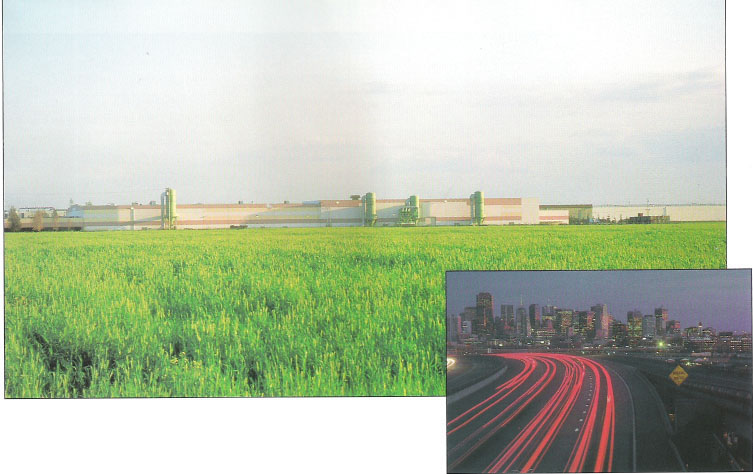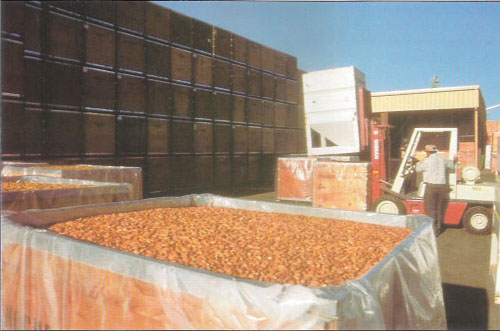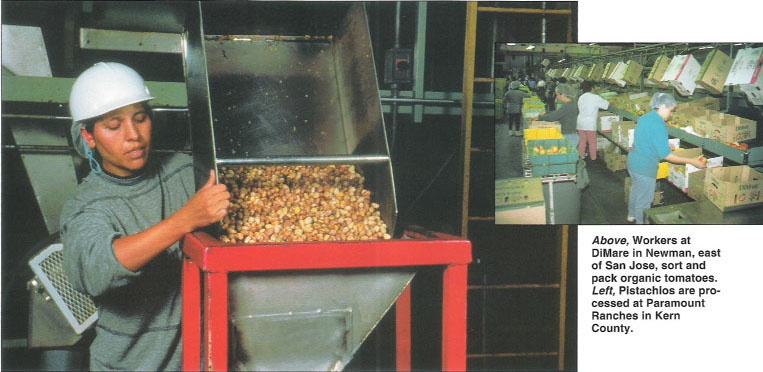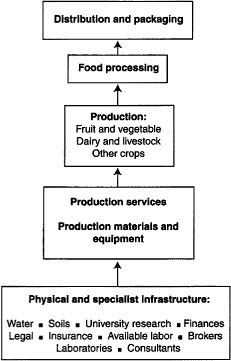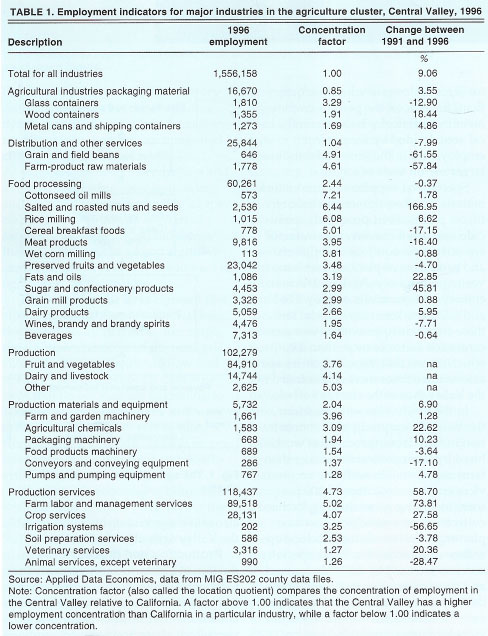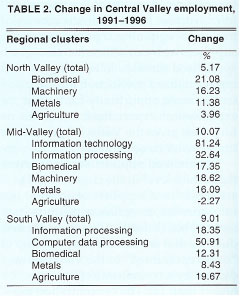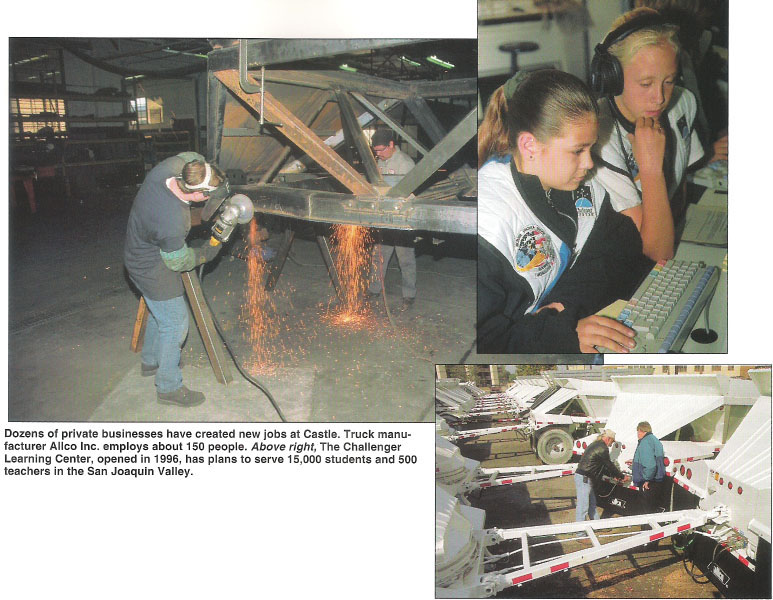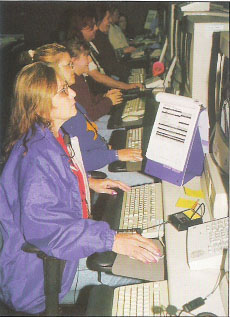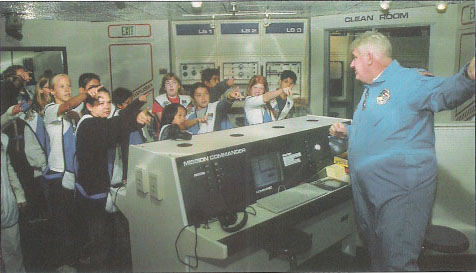All Issues
How will the Central Valley economy grow?
Publication Information
California Agriculture 54(1):41-47. https://doi.org/10.3733/ca.v054n01p41
Published January 01, 2000
PDF | Citation | Permissions
Abstract
The Central Valley's economy is becoming increasingly bifurcated, with a new economy overlaying the traditional agricultural economy. Two distinctive economic forces are responsible for this transformation of the Valley's indigenous agricultural economy. The first is the continuing development of agriculture from commodity production to more specialized, integrated clusters of agricultural industry. The second is the emergence of nonagricultural industries, based on industries such as information technology and biomedical supplies. The health of the Valley's economy will continue to rest heavily on production agriculture, which supports many related businesses. However, the lack of workers possessing skills needed for the newer nonagricultural jobs may limit progress in Valley communities.
Full text
The emergence of nonagricultural industries, as well as spillover population from urban areas such as San Francisco, are transforming the Central Valley.
The Central Valley poses a challenging question about the source of continuing economic growth: agriculture is the region's major industry and agricultural employment is declining both in proportion and real numbers (especially farmers and nonseasonal workers; Carter and Goldman 1996), so how is it possible that the Valley population and economy continue to grow at rates greatly exceeding the state average? What is the source of growth in the Valley that promises to triple in population by 2040 (California Department of Finance 1993), making it one of the state's fastest-growing regions and threatening to pave over more than a million acres of farmland (Bradshaw and Muller 1998)?
California's growth and regional character involve the interplay of many different forces operating at the same time, often in the same area. The Central Valley is being shaped by migration, which induces jobs, and by economic growth, which attracts population. The most visible source of population growth is commuters, urban workers living farther and farther into the agricultural regions while working in the Bay Area or the Los Angeles Basin. Equally important, immigrants from Latin America. Asia and around the globe, as well as retirees and independent business persons, are attracted to the Valley for its affordability and lifestyle, as well as jobs.
Two distinctive economic forces are continuing to transform the Valley's indigenous agricultural economy into a new, growth-based, technology driven, export-oriented, 21st-century economy. The first is the continuing development of agriculture from commodity production into an integrated cluster of agricultural industries. Alongside commodity production and primary processing, new industries such as fresh lettuce packaging or specialty almond products are part of a set of related agricultural industries that are almost as large and significant, and which multiply the impact of agriculture in the region.
The second is the development of a strong nonagricultural industrial base. Because it is still in a formative stage, the ultimate character of the nonagricultural base is difficult to know and predict. However, enough data now exist that its outlines are beginning to take shape. This new Valley economy is both integrated into and isolated from the state's “urban” coastal economies such as the Bay Area and Southern California.
The Valley's economy is bifurcated, with the new economy overlaying the older traditional rural economy. The Valley has its share of declining industries, workers displaced by farm mechanization, and people in inefficient workplaces without access to adequate investment capital. This old economy, which contributes to local unemployment rates that are double or triple the state average of just below 5%, includes many people who lack the skills and capacity to fully participate in the Valley's emerging industries (Bradshaw 1993). The new economy, with its demand for technical skills and information specialists, rarely draws from or benefits those who have their roots in the old.
The notion of industrial clusters is a useful analytical tool to describe these forces of change. Clusters are sets of interrelated industries in a region whose firms gain advantages because they are located near each other and because they share supplier and postproduction specialization that is unique to the area (Bradshaw et al. 1999; Held 1996; Porter 1995). Clusters have to do business outside the local area, and bring in money other than local money. The prototypical cluster is Silicon Valley, where research universities, innovative designers, chip manufacturers, production equipment companies and consumer-goods producers all gain advantages by being in the same region. Clusters are used to identify multiple, related industries that provide regional advantages and induce growth. This report covers a 20-county area from Shasta to Kern counties, and uses data from the California Labor Market Information ES202 workers data files, which include all workers except those self-employed. The most recent data available are for 1996 and comparisons are made to 1991.
The agricultural cluster
Agriculture is the Valley's largest employer, but the complex, multilevel, integrated development of this industry is what makes it strong. Agriculture accounted for over $3.4 billion in sales in 1997 in Fresno County alone, and in the eight-county San Joaquin Valley area, production came to $14.4 billion (CDFA 1998).
Based on fertile soils and ample water, agricultural production for many California crops leads the nation. The primary dynamic in California agriculture, however, is the increasing transition to higher-value crops such as wine grapes, stone fruits, almonds or organic vegetables, which on average require more labor. In general, the increases in labor demanded for specialty high-value crops compensate for the ongoing labor savings from mechanization that continue to displace farmworkers from routine tasks and from lower-value crops. More significantly, the new crops also require more specialized inputs, more elaborate processing, and increased reliance on information from researchers, consultants, investors, marketers and their specialist infrastructure.
Agricultural infrastructure.
The foundation of the Valley's agricultural cluster is the natural resource base and the specialized physical and social infrastructure that supports supplier industries, which in turn support production of commodities, which are further processed and finally marketed (fig. 1). The Valley's unique water, soils and climate give agriculture an advantage, but value is multiplied because of the social infrastructure of support specialists in agricultural research, law, banking and financing, crop insurance, commodity brokering, soil testing, industrial technologies, marketing, accounting, tax advising and many other businesses. It is hard to quantify employment in this sector, however, since most specialties are not separated from their institutional settings.
Above, Workers at DiMare in Newman, east of San Jose, sort and pack organic tomatoes. Left, Pistachios are processed at Paramount Ranches in Kern County.
The critical contribution of the specialist infrastructure is the qualitative advantage that it provides for innovation in new crops, processes and products. UC is one of the most visible infrastructure components for its contribution of agricultural research, but partnerships with the private sector multiply the impact of campus-initiated efforts. For example, cooperative research led to integrated pest management and sustainable farming systems that are proving not only viable but economically attractive.
These innovations are available in the Valley because of the huge market for specialized research. The specialist infrastructure helps stimulate concentrations of agricultural producers and suppliers who can utilize increasingly specialized services. In turn, a growing specialized production industry creates more opportunity for further expansion of a specialized infrastructure. This gives the Valley's agricultural cluster its advantage.
Specialized support services.
At the second level in the cluster (fig. 1), are specialized suppliers of agricultural services, materials and equipment (table 1). table 1 lists only the industries that are significantly “over-represented” in the Valley as indicated by a concentration factor higher than 1.0. The concentration factor is also known as a location quotient, the ratio of the percent employment in a particular industry in the local area divided by the percent employment in the same industry in a larger region such as a state.
Specialized suppliers of production materials and equipment include fertilizer plants, seed producers, pesticide and other chemical manufacturers, irrigation-equipment suppliers, and producers of planting and harvesting machinery. Agricultural machinery and chemicals employ 1,661 and 1,583 workers respectively, and these two industries both have a concentration factor of more than 3.0, which means that these industries are at least three times more concentrated in the Valley than in the state as a whole.
In the production services sector, the Valley has a predictable concentration in farm labor (production workers hired by labor contractors rather than farm managers). In addition, crop services employ more than 28,000 persons, including aerial dusting, orchard cultivation, entomological services, planting- and harvesting-machine operation and other jobs. These specialty services are used by multiple farmers and provide services that would be difficult for individual growers to provide for themselves. Veterinary services for farm animals and poultry also make significant contributions to the Valley agricultural industry.
Production and processing.
Production in California agriculture is the focal point of the cluster. Employment can be broken into three large, interrelated industrial clusters — fruits and vegetables, dairy and livestock, and other agricultural crops (table 1). The Valley agricultural cluster processes, packages and distributes what the farmer grows. These industries employ nearly 100,000 persons, mostly in the processing of fruits and vegetables. Canning and freezing are only the first parts of the processing industry, with increasing numbers of firms making convenience and gourmet foods. A growing segment of this industry is aimed at export around the world. Almond processing in the nut industry, for example, is highly concentrated and growing considerably.
In sum, agriculture is still the core of the Valley economy. The Central Valley had a total of 1.5 million employed persons in 1996, with farm work comprising about 12.5% of the total. Another 135,000 people are employed in other parts of the cluster, in production materials, equipment and services as well as food processing, packaging and distribution. These related jobs constitute an additional 9% of total Valley employment. In total, these sectors conservatively represent a solid core of between one-fifth and one-quarter of Valley employment. The newer industries in the agricultural clusters, such as production materials and services as well as some processing industries, are also showing positive growth. However, even with this advantage, the data also show that newer industries are not pulling the older production, or commodity, part of the cluster to a faster growth rate than Valley employment overall.
TABLE 1. Employment indicators for major industries in the agriculture cluster, Central Valley, 1996
Castle Air Force Base in Merced County was vacated by the military in September 1995, but is experiencing new life. An aviation museum occupies 18 acres of the 2,800-acre facility.
Nonagricultural clusters
While the agricultural cluster is the dominant economic base in the Valley, agriculture does not account for all of the Valley's strong economic and population growth. New industries are emerging. Unlike agriculture, which has strong vertical linkages to its support industries, the new industries are more geographically specific and are “emerging” in clusters whose regional advantages are underdeveloped.
Dozens of private businesses have created new jobs at Castle. Truck manufacturer Allco Inc. employs about 150 people. Above right, The Challenger Learning Center, opened in 1996, has plans to serve 15,000 students and 500 teachers in the San Joaquin Valley.
This discussion focuses on three regions — the North Valley (Colusa to Shasta counties), the Mid-Valley (Sutter to Sacramento) and the South Valley (San Joaquin to Kern) — and emphasizes the industries that may form the core of the new economy (table 2). For example, transportation, tourism and utilities have grown in the Valley, but they lack a core of support industries that would make them a cluster. Similarly, the “nonbasic” industries that only serve local populations are not considered a cluster because they do not bring wealth into the Valley. Likewise, local government, construction, retail stores and most transportation services have large employment levels, but they are responsive to the wealth generated by other industries. The key to identifying the nonagricultural economic strength of the Valley is to identify the primary “motors” of growth. The first place to look is in the diversification of industries that have regional, national and global markets.
Castle Air Force Base in Merced County may illustrate the dynamic quality of diversification going on in the Valley. In 1995, the base closed and nearly 6,000 employees were relocated to other areas or lost their military jobs. While the displacement was only a minor economic setback for the county (Bradshaw 1999), an interesting, dynamic transition is taking place in base reuse. The Castle Joint Powers Authority, formed to redevelop the base, initially leased some of its warehouse space to a food processor for storage. But later, Pacific Telesis moved its service center, which currently employs more than 1,000 workers, to the closed commissary and other buildings. Then a construction firm located on the base because it needed lots of open space for construction and storage of portable buildings for classrooms. This firm now employs 500 workers. New recreation-education firms also found space at the base — for example, Aviation Challenge employs 45 in an educational space camp for kids. For a time, a blimp manufacturer found space at the closed airbase. The new firms were largely in growth industries rather than local relocations, and most of the jobs were new to the county. Virtually all of the firms draw revenue from outside the local area.
While the industries reusing Castle Air Force Base do not yet show promise of developing into an independent cluster, the mix of new industries illustrates the dynamic diversification of the new Valley economy. Telecommunications, recreation, education and new forms of construction are supplementing and indeed overlaying the traditional economy.
While these nonagricultural clusters have been growing fast since 1991, they are not yet concentrated at high levels. However, each has some component of local supply strength, which implies continued growth potential (table 2).
Information and electronics.
First, in the Mid-Valley, the information technology cluster continues to expand, led by the electronics industry northeast of Sacramento. In this subregion, the core of the information technology sector now employs 8,200 workers and expanded 142% between 1991 and 1996. The part of the cluster that supplies components and services for the information technology industries employs another 9,800 persons and expanded 50%. In short, this industry is helping drive the Mid-Valley economy. Along with state government and associated professional service industries, it is not surprising that the Mid-Valley is growing so strongly.
The information-technology industry is expanding rapidly in the mid-Central Valley region. Pacific Telesis signed a 20-year lease at Castle Air Force Base.
Biomedical/health.
The Mid-Valley electronics cluster is also strongly linked to the biomedical/health industry cluster, which employs 68,000 persons, one in every eight employees in that area. Between 1991 and 1996 the cluster grew 17% compared to the region's overall rate of employment growth of 10%. Within the cluster, specialties such as drug manufacturing now employ nearly 600 persons, and medical instruments and supplies employ another 775 persons. Furthermore, links with the electronics industry in the Mid-Valley support growing employment in medical and hospital equipment and measuring-and-controlling-device manufacturers, which now employ 1,500 persons. These two industries both had over 50% growth from 1991 to 1996. The high-technology capacity of the Mid-Valley is evident in the new industries. These clusters build on the universities and government agency facilities in the region, and promise to become an increasingly strong part of the Valley economy.
Diversification.
The North Valley has the least developed nonagricultural clusters compared to other Valley regions, but is showing signs of diversification. Fabricated metals and machinery clusters are emerging as important industries. Both of these have relatively small employment, but together they now employ 2,300 workers, up 11% and 16%, respectively, from 1991. The North Valley's biomedical cluster has grown 21% from 1991 to 1996. While it is not a major part of the state's medical industry, it now employs nearly 18,000 persons, nearly 10% of the regional employment. The most rapid growth is in several highly specialized industrial sectors such as medical instruments, measuring-and-controlling devices, hospital equipment and patient care services.
Computers and data processing.
The South Valley remains particularly strong in its agricultural base, which expanded by nearly 30%. Even so, nonagricultural clusters are emerging. What stands out in the South Valley is the information processing cluster, which now employs over 17,000 persons and grew at a rate of more than 18% from 1991 to 1996, double the 9% rate for the region as a whole. Leading the employment growth in this cluster is computer and data processing services, which posted a more than 50% increase from 1991 to 1996. The information industry is highly visible here, as back-office data processing firms fill the many new office buildings and industrial parks in Fresno, Bakersfield and Visalia. The primary requirements for information processing is the labor force and high-capacity telecommunications systems. Businesses are attracted to low-cost office space, high quality of life, and adequate training programs to supply labor.
The South Valley also shows expanding biomedical employment. Medical instruments and supplies and ophthalmic goods lead the sector, which grew at a 30% rate. Overall this biomedical cluster employs nearly 85,000 persons in the South Valley, though most of that is in health services. In parts of the South Valley, medical specialization is becoming stronger over time. For example, a concentration of medical instruments and supply firms and ophthalmic suppliers grew 70% between 1991 and 1996, well over the state growth rate for these types of firms. In sum, the data show a consistent pattern of growing strength in the Valley in high technology and information industries. These emerging industrial clusters will be the backbone of the Valley's future economic strength.
Future in focus: Challenges for the new economy
The Valley faces several challenges with its growing high-technology economy. First, the core is in agriculture and will probably remain so for the foreseeable future. However, agricultural production and its support services, which are the backbone of the agricultural infrastructure cluster, are in a delicate balance. These specialized services and expertise are located in the Valley because agricultural production is vibrant there; they provide competitive strength for the Valley, as they represent an investment that benefits local farmers as well as people outside the region.
As in most clusters, the firms that provide technical skills also serve firms outside the cluster area, creating an export commodity that actually brings in additional wealth. However, if agricultural production weakens or no longer nurtures its specialized infrastructure, then the cluster will begin to decay and move elsewhere. Reduction in water supply or urbanization — including land-use changes that convert farmland to urban uses or that allow large zones of conflict around urban lands — could significantly limit the production that fuels related service industries (Sokolow and Spezia 1992).
Second, the Valley's emerging economy is specialized, complex and rapidly changing. It is built upon skills and information. However, the Valley lacks an abundance of highly skilled workers. Workforce development remains a serious challenge. Throughout the Valley we hear stories of employers who can not find the skilled workers they need. As a consequence of large numbers of workers who have communication difficulties and insufficient education, progress toward a new economy is limited in many Valley communities ( see p. 26 ). In addition, seemingly unsophisticated jobs such as warehouse workers are hard to fill because they now involve some quantitative and computer skills. In one case, a warehouse employer reported that the company could hire only one in 20 applicants because they lacked adequate language and arithmetic skills, or had recent criminal or drug records.
While the Valley's limited educational and work-force preparation programs may restrict future economic growth, more likely it will perpetuate the bifurcation that has characterized rural areas. Underskilled workers fail to find a place in the new economy and are increasingly bypassed, while workers from the high-technology urban centers are encouraged to relocate to the Valley. The new UC campus in Merced may help produce some of the higher-skilled workers needed for emerging industrial clusters, but the benefits from a new campus are years or decades away and will probably not help displaced workers who are bypassed by the new economy.
Finally, there is no guarantee that any of the clusters present or emerging in the Valley will be able to successfully compete and become international centers for excellence and innovation over the next 25 years. The stakes and risks are high: while the potential for development is real and the possible benefits are great, these industries face stiff competition from the coastal regions in California.
Students improve their skills in math, science, aerospace technology, problem-solving and teamwork at Castle.
The California Economic Strategy Panel (1996) noted:
California's economy has changed in fundamental ways in the past decade and California's business, government, education and community leaders must respond in equally fundamental ways if the state is to retain its competitive edge in the 21st century. In short, California needs a new model of collaborative governance that fits the new realities of a 21st-century economy.
Since companies can invest anywhere in the world, a new role for government in the 21st century will be collaboration with public and private partners, including universities, to assure that there is specialized infrastructure in place to support the clusters that will sustain the economy and lifestyle of Valley residents. For instance, government agencies that issue permits and regulate zoning, labor and safety, must increasingly act in cooperation rather than in isolation. Public agencies that provide work-force training, economic development, and welfare must work in partnership with private firms to set goals for the investment of public funds and allocation of staff efforts. Cities and counties must also overcome local competition and begin to collaborate with each other to build regional excellence. Knowledge and technological innovations from universities must be shared broadly to develop the regional advantage that will foster clusters. In these ways, success of the new Valley clusters will depend on building a strong foundation of collaboration among the many public, private, and university interests that traditionally have been in competition.



